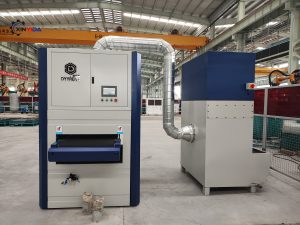In the competitive landscape of modern manufacturing, workplace safety is paramount. As industries focus on enhancing production efficiency and minimizing risks, high-efficiency sheet metal polishing and deburring machines are revolutionizing how companies approach worker safety. These advanced machines play a crucial role in reducing workplace hazards such as harmful dust exposure, sharp edges, and repetitive strain injuries. Here’s a deeper look at how automated metal finishing systems are transforming workplace safety and health in the metal fabrication industry.

1. Reducing Exposure to Hazardous Metal Dust
In industries like sheet metal fabrication, workers often face the risk of inhaling fine metal dust generated during polishing and deburring tasks. Over time, this dust can lead to respiratory issues, making it essential to find effective ways to reduce exposure.
High-efficiency deburring and polishing machines are equipped with state-of-the-art dust collection systems that capture metal particles at the source. By reducing airborne contaminants, these machines significantly improve air quality in the workplace and help mitigate the health risks associated with respiratory diseases. In turn, this creates a safer environment for workers who no longer need to handle toxic dust manually.
2. Minimizing Risks from Sharp Edges and Burrs
Sharp edges and burrs on metal parts pose a significant risk of cuts, abrasions, and punctures to workers. Manual deburring, while necessary, often requires direct handling of these sharp edges, which can lead to accidents.
With automated polishing and deburring machines, sharp edges are efficiently smoothed out without the need for manual contact. This automated metal finishing process reduces the risk of injury by eliminating the dangerous task of manually handling sharp materials. Workers are now able to focus on safer, less strenuous tasks, leading to fewer injuries and greater safety.
3. Reducing Repetitive Stress Injuries (RSI)
Repetitive stress injuries (RSIs) are common in environments where workers perform the same motions continuously, such as hand polishing or deburring tasks. These injuries, such as carpal tunnel syndrome and tendonitis, can significantly affect workers’ well-being and productivity.
Automating these repetitive tasks with high-efficiency deburring machines allows workers to avoid the strain and physical stress associated with constant manual labor. This reduces the occurrence of RSIs and promotes better worker health over time. In turn, this results in a more productive workforce and lower rates of work-related injuries.
4. Improving Productivity and Reducing Worker Fatigue
Manual deburring and polishing can be physically taxing, leading to fatigue and decreased concentration, which increases the risk of accidents. Automated metal finishing machines, however, take over the strenuous task of polishing and deburring, significantly boosting production efficiency.
These machines operate quickly and consistently, relieving workers from physically demanding tasks. As a result, employees are less fatigued and more focused on other essential functions, increasing overall workplace productivity. With less fatigue, workers are also less likely to make errors, thereby reducing the chance of workplace accidents.
5. Ensuring Precision, Consistency, and Quality Control
Manual deburring and polishing often lead to inconsistencies in the final product, with defects such as uneven surfaces or improperly smoothed edges. These errors can result in additional work, rework, and potential safety hazards.
Automated deburring and polishing systems ensure consistent results every time, offering precision that manual processes can’t match. These high-precision machines guarantee that metal parts are smooth, polished, and free of burrs, thus improving quality control and reducing defects. By minimizing human error, these machines also lower the risk of defects that could lead to workplace accidents or the need for rework.
The Importance of High-Efficiency Polishing and Deburring Machines in Manufacturing
Incorporating high-efficiency sheet metal polishing machinesand deburring machines into your manufacturing process isn’t just about improving production efficiency—it’s also about prioritizing workplace safety. These advanced machines help reduce harmful dust exposure, minimize injuries from sharp metal edges, and alleviate the physical strain caused by repetitive tasks. As a result, companies can provide workers with a safer, more comfortable work environment while improving overall productivity and metal finishing quality.
Ready to enhance the safety and efficiency of your operations? Contact us today to learn more about our automated deburring and polishing machines, and how they can transform your metal fabrication process.
